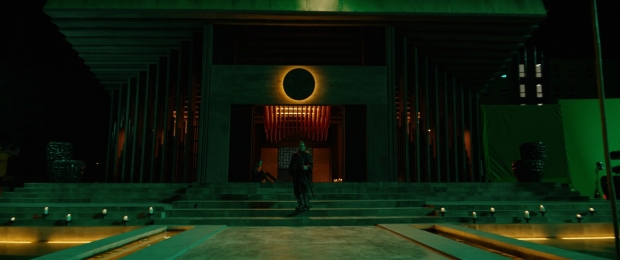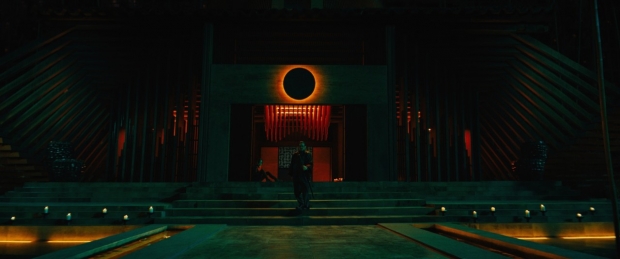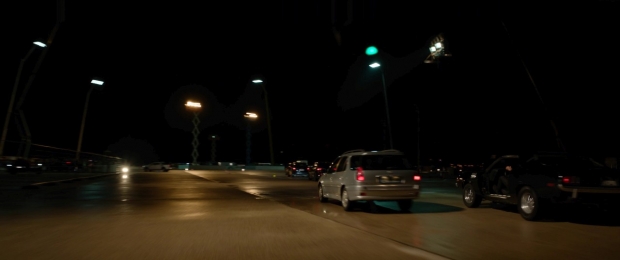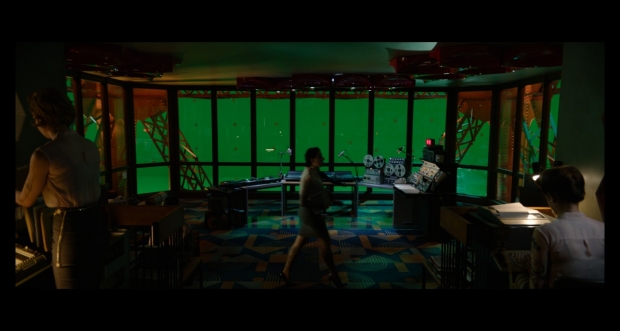Collaborators Jonathan Rothbart, Janelle Croshaw Ralla, and Michael Ralla talk incendiary shotgun shells, a blind assassin’s eyeballs, a CG dog, and hundreds of ring finger removals, on Chad Stahelski and Lionsgate’s shoot ‘em up in volume action-adventure.
Even super badass John Wick can’t survive on his own, often requiring a bit of help from his formidable group of friends to survive the never-ending assaults that liven up his existance. This spirit of collaboration was central to the production of Lionsgate’s shoot ‘em up in volume action thriller, John Wick: Chapter 4, which relied upon the visual effects team of Jonathan Rothbart looking after pre-production and principal photography, Janelle Croshaw Ralla taking over post-production, and Michael Ralla doing some last-minute pinch hitting.
Nighttime was the right time for the scenes captured in Berlin, which was not a problem for Rothbart, who shares, “I would go home from the shoot each day and bringing out my iPad, get on FaceTime and be able to hang out with my family in California as they had dinner! Chad Stahelski and I were the two people onset who were always happy and fine with the night shoots.” Open communication was essential when dealing with the film’s expansive stunt and special effects teams so critical to the movie’s success. “I love [SFX Supervisor] Gerd Nefzer and the stunt team led by Stephen Dunlevy and Scott Rogers,” Rothbart says. “I learned so much about stunt work and the way they go about doing them on a John Wick film, which is unlike any other film that I’ve worked on. Those guys go out there. Keanu Reeves does most of his fighting so there were almost no face replacements and wire removals.”
Storyboards and previs were created for the Arc de Triomphe car chase and the top-down shot of Wick moving through a Parisian apartment firing incendiary shotgun shells known as Dragon’s Breath, which was extremely technical to execute. “Other than those two scenes, there was very little storyboards and previs,” notes Rothbart. “A lot of it relied upon working with the stunt team and the other departments to figure out what we’re going to do. Stunts would do stuntvis, where they filmed themselves, and we worked with them for any CG involved with that shoot. Then on the day, Chad would take pieces of what he liked. That can be stressful, but I enjoyed that part of it too because you have to think on your feet. In the car chase, I was working with the stunt team to figure out what tools we were going to use. Chad wanted multiple car hits in a single shot while John Wick was fighting so we had to come up with a system that would allow Keanu to move in and out freely and safely. We developed this sled system where we had the front of the sled match the profile of the different cars that were padded and safe, which they could hit at a higher speed than you would a car. We would replace the entire car later on, but the actual fights and hits were live in-camera.”
As for the top-down shot, it literally looks like a flamethrower has been unleased, but is in fact a 12-gauge shotgun. “The shotgun shells have magnesium pellets so as soon as the magnesium hits the air it ignites and creates a flame that has a specific look,” explains Rothbart. “One of the reasons why we wanted to use that gun is from a top view it’s so dynamic and tells a story in a way that shooting a gun may not. We spent a lot of time helping to design the set and the path to move through it. We had to figure out what was going to be the correct distance for the Dragon’s Breath so we knew how far Keanu had to stand away when shooting the shotgun, and where to fill the pieces in the set that get torched by the Dragon’s Breath magnesium, so we would create real fire moments throughout. We also tried to create areas where Keanu could jump onto things because if you’re just looking straight down and everybody stays on the same height plane, you lose a lot of dynamics that you would get when shooting horizontally. We wanted to create some moments where he would come close to and further away from camera. That was definitely the most choreographed scene in terms of specific timings of people and things happening in the movie.”
When it came to creating 1,523 visual effects shots in post-production, Janelle Croshaw Ralla collaborated with WeFX, Light VFX, Rodeo FX, Pixomondo, One of Us, The Yard, Tryptyc, Boxel, Crafty Apes, Atomic Arts, Mavericks VFX, Incessant Rain, and Fotokem. A significant part of the work was having to do hundreds of finger removals to ensure story continuity. “The finger removals didn’t sneak in until the very end,” she laughs. “Throughout the entire shoot, Keanu wore a black condom on his ring finger, which he chopped off in John Wick: Chapter 3. The hope was it’s a dark movie and the black sleeve would make it so we didn’t have to do all of the finger removals. But our director was very meticulous, so every single shot where we remotely saw his finger, we would reconstruct it, get rid of the black sleeve, and add in a nub. Rather than sharing that many shots by having a finger only vendor, we had each vendor do their own finger removals. It was an interesting process matching continuity and sharing setups amongst vendors because some were done all 2D, some 2.5D and others were full 3D. This is something that goes by and hopefully the audience doesn’t even notice.”
As in Rogue One: A Star Wars Story, martials arts legend Donnie Yen portrays a lethal blind character, which meant that digital work had to be done on his eyes. “The original idea for Caine’s eyes was that his eye sockets would be hollowed out because he took his own sight,” remarks Janelle Croshaw Ralla. “When we started to get into the style frames and concept art of what that was going to look like, it became apparent what we were going to be up against because if you hollow out the eye socket, the upper and lower eyelid are going to cave in and it’s not a pretty sight. If they don’t cave in it appears quite odd as the eyelids will protrude out as if there’s an invisible eyeball.”
She continues, “The biggest problem was that it took away from the performance. Even though Caine is blind you still want to see all the subtle, nuanced performance. The way his eyeballs move around is quite instrumental. We ended up with a cloudy look that was first established with our inhouse team that almost looked like cataracts. There are slice wound scars on the upper and lower eyelids. On the eyeball itself, upon healing it created this cloudy diluted look. The hero shots are in the Osaka Continental bamboo forest when he takes off his glasses, but similar to the finger, it is sprinkled in throughout the film but often imperceptible because it’s behind his glasses.”
Paris-based Light VFX, led by founder and CEO Antoine Moulineau and COO Gullaume Raffi, handled 183 shots, ranging from CG dog shots in the Arc de Triomphe chase sequence to stair fight enhancements, graffiti on trains, the opening desert scene and extremely difficult finger removals. “They shot a plate with a real dog holding onto the wrist,” Moulineau reveals. “We did a CG takeover so the dog wouldn’t get hurt when it was thrown and hit by a car. There was no scan of the dog because it came late in the game, but we had plenty of photography. You see things clearly because the shot was full screen. It helps that you have more than one light source, so the lighting is more dynamic than in daytime. The real dog was actually shot against bluescreen; however, she was really smiling so it didn’t work at all! We body tracked the real dog, replaced her with a digital one and made her angry.”
Some faces and mats had to be replaced during the long sequence when John Wick rolls down two flights of stairs. “It was shot in two takes, so we had to do transitions and blend them together by using camera projections in the background and a lot of the stairs had to be rebuilt in CG because it was too much cleanup,” Moulineau adds.
Noting skies had to be replaced for the opening desert scene, Moulineau continues, “We rebuilt some of dunes in CG where the crew was walking. By the end of the show, the director realized there was not enough of Keanu in the scene. The reshoot was shot in California rather than Wadi Rum so we had to do background replacements.”
To ensure that the virtual and practical camerawork matched one another, additional visual effects supervisor Michael Ralla had to make sure that the lenses used by cinematographer Dan Laustsen were emulated correctly. “That has been an interesting aspect on this film and building on some of the recent development that I’ve been doing on Black Panther: Wakanda Forever,” reveals Michael Ralla. “Dan was using a set of ARRI ALFA lenses, which are essentially modified and customized ARRI Master Anamorphics that have been expanded to cover a large format sensor; they have some specific aberrations that we were trying not just to eyeball but actually be more specific about what they are and how the lenses impact the image.” The challenge was to make the lens imperfections appear natural rather than calculated inside of a computer. Michael Ralla continues, “It’s all about bridging the gap between those two worlds. You definitely want to have any kind of CG element inherit the same characteristics that you have in the live-action photography. From what I understand the ARRI ALFA was made specifically for Greig Fraser as per his specs and detuned for him. It has a subtle flaring and has more coma than you would ever expect. Coma are those little comet trails that appear as you get closer to edge of the frame. A huge aspect is understanding what you see.”






















